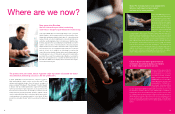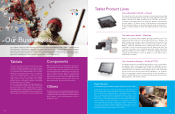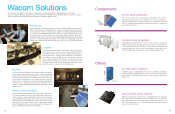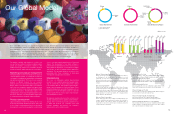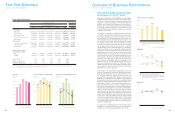Wacom 2010 Annual Report Download - page 16
Download and view the complete annual report
Please find page 16 of the 2010 Wacom annual report below. You can navigate through the pages in the report by either clicking on the pages listed below, or by using the keyword search tool below to find specific information within the annual report.
29
(Additional information)
Useful lives of machinery and equipment were
changed to conform with the Corporate Tax Law as
revised for the fiscal year ended March 31, 2009. The
impact to the consolidated statement of income is not
significant.
(b) Intangible assets:
The Company adopted the straight-line method for
computing amortization. Software for in-house use is
amortized based on the straight-line method over the
expected useful economic life of 5 years. Software
for sale is amortized based on an estimated volume of
sales, with the minimum amortization amount calcu-
lated based on a useful life of 3 years.
(4) Basis of provision -
(a) Allowance for doubtful accounts:
An allowance for doubtful accounts is provided in an
amount sufficient to cover probable losses on
collection of notes and accounts receivable. The
allowance for doubtful accounts is computed based a
calculated historical bad debt experience ratio for
trade receivables, in addition to the estimated
irrecoverable amount of doubtful receivables on an
individual account basis.
Foreign consolidated subsidiaries mainly compute the
allowance for doubtful accounts based on the
estimated irrecoverable amount of doubtful receiv-
ables on an individual account basis.
(b) Provisions for bonuses:
The provisions for bonuses to employees are provided
based on estimated amounts expected to be paid to
employees.
(c) Provisions for directors’ and statutory corporate
auditors’ bonuses:
The provisions for directors’ and statutory corporate
auditors’ bonuses are provided based on estimated
amounts expected to be paid to directors and
statutory corporate auditors.
(d) Provision for retirement benefits:
The provision for retirement benefits for employees is
provided based on the actuarially calculated present
value of projected benefit obligations except for, as
permitted under the accounting standard for employ-
ees’ retirement benefits, the unrecognized actuarial
differences. The unrecognized actuarial differences
are amortized on a straight-line basis over 5 years
beginning in the year after they arise. An entire
amount of the unrecognized actuarial differences are
amortized as incurred at a part of the foreign consoli-
dated subsidiaries.
(Accounting changes)
“Partial Amendments to Accounting Standard for
Retirement Benefits (Part 3)” (Accounting Standards
Board of Japan Statement No. 19, issued on July 31,
2008) has been adopted effective for the fiscal year
ended March 31, 2010. The unrecognized actuarial
differences will be amortized from the following fiscal
year. Therefore, operating profit, ordinary income and
income before income taxes will not be affected for
the fiscal year ended March 31, 2010. An unrecog-
nized amount of differences for retirement benefits
liabilities raised from the adoption of this accounting
standard is
¥
28,167 thousand ($303 thousand).
(e) Provision for directors’ and statutory corporate
auditors’ retirement benefits:
The Company provides an accrued lump-sum
severance indemnity for directors and statutory
corporate auditors at the full amount which would be
required to be paid if all directors and statutory
corporate auditors retired at the balance sheet date
based on the Company’s internal regulations.
(5) Foreign currency translation -
The Company’s functional currency is Japanese yen.
The translation of assets and liabilities denominated in
foreign currency at the year-end is made at the
current exchange rate. Exchange gains and losses
resulting from foreign currency transactions and
translation of assets and liabilities denominated in
foreign currencies are included in the consolidated
statements of income. All assets, liabilities, income
and expense accounts of foreign subsidiaries are
translated using the current exchange rates at the
respective balance sheet dates. Foreign currency
translation adjustments resulting from such proce-
dures are recorded in the consolidated balance
sheets as a separate component of net assets.
(6) Consumption taxes -
The consumption tax withheld upon sale and
consumption tax paid by the Companies on their
purchases of goods and services is not included in
revenue and cost or expense items in the accompany-
ing consolidated statements of income.
(7) Valuation method for assets and liabilities of
subsidiaries -
Assets and liabilities of subsidiaries are measured at
fair value at the date of acquisition.
(8) Amortization of goodwill -
Goodwill is amortized straight-line over the remaining
useful life.
(9) Cash and cash equivalents -
Cash and cash equivalents include all highly liquid
investments, generally with original maturities of three
months or less, those that are readily convertible to
known amounts of cash and, thus, present an
insignificant risk of changes in value.
3. Changes in accounting principles and policies:
Changes in accounting principles and policies for the
year ended March 31, 2009 were as follows.
(1) Practical solution on unification of accounting policies
applied to foreign subsidiaries for the consolidated
financial statements -
“Practical Solution on Unification of Accounting Policies
Applied to Foreign Subsidiaries for the Consolidated
Financial Statements” (Accounting Standards Board
of Japan Practical Issues Task Force No. 18 issued on
May 17, 2006) has been adopted effective for the fiscal
year ended March 31, 2009. As a result, operating profit,
ordinary income and income before income taxes are
decreased by
¥
17,576 thousand compared with what
would have been reported under the previous accounting
policy that consolidated subsidiaries overseas had
applied generally accepted accounting principles in each
country to their own financial statements and no adjust-
ments had been made to their financial statements on
consolidation. The impact on segment information is
explained in Note 16.
(2) Lease accounting -
Finance lease transactions that do not transfer ownership
of the assets had been accounted for using the same
method as for operating leases. However, “Accounting
Standard for Lease Transactions” (Accounting Standards
Board of Japan Statement No. 13, originally issued on
June 17, 1993 and revised on March 30, 2007) and
“Guidance on Accounting Standard for Lease Transac-
tions” (Accounting Standards Board of Japan Guidance
No. 16, originally issued on January 18, 1994 and revised
on March 30, 2007) have been adopted effective from the
fiscal year beginning on and after April 1, 2008. Therefore
finance lease transactions that do not transfer ownership
of the assets were treated as ordinary sales transactions.
As for finance lease transactions that do not transfer
ownership which commenced before April 1, 2008, the
Company has applied the same method as for operating
leases continuously.The adoption did not have any
impact on the consolidated statement of income.
4. Changes in presentation methods:
Changes in accounting principles and policies for the year
ended March 31, 2009 were as follows.
(Consolidated Balance Sheets)
(1) “Merchandise and finished goods”, “Work in process”
and “Raw materials and supplies” accounts are separately
presented from this fiscal year, which was included in
“Inventories” presentation in the previous years. “Merchan-
dise and finished goods”, “Work in process” and “Raw
materials and supplies” represented ¥2,349,469 thousand,
¥177,043 thousand and ¥847,171 thousand, respectively in
the previous year.
(2) “Tools, furniture and fixtures” account and its “Accumu-
lated depreciation” account is separately presented from this
fiscal year, which was included in “Others” of “Property,
plant and equipment” in the previous fiscal years, as its
significance has increased. Each amount of “Tools, furniture
and fixtures” account and its “Accumulated depreciation”
account in the previous year is ¥1,454,331 thousand and
¥1,079,531 thousand, respectively.
Changes in accounting principles and policies for the year
ended March 31, 2010 are as follows.
(Consolidated Balance Sheets)
(1) “Accounts receivable - other” account is separately
presented from this fiscal year, which was included in
“Others” of “Total current assets” in the previous fiscal years,
as its significance has increased. The amount of “Accounts
receivable - other” account in the previous year is ¥897,994
thousand.
30
March 31, 2010 March 31, 2010
Thousands of
U.S. dollars
Thousands of
yen
Amount of overdraft limit
Utilized overdraft facilities
Net amount
¥2,000,000
–
¥2,000,000
March 31, 2009
¥2,000,000
–
¥2,000,000
$21,496
–
$21,496
(Consolidated Cash Flow Statements)
(1) “Payments for lease and guarantee deposits” account
and “Proceeds from collection of lease and guarantee
deposits” account of “Net cash provided by (used in)
investing activities” is included in “Others, net” of “Net cash
provided by (used in) investing activities” from this fiscal
year, as its significance has decreased. The amount of
“Payments for lease and guarantee deposits” account and
“Proceeds from collection of lease and guarantee deposits”
account which is included in “Others, net” of “Net cash
provided by (used in) investing activities” in this fiscal year is
¥9,253 thousand ($99 thousand) and ¥881 thousand ($9
thousand), respectively.
5. Consolidated balance sheets:
Information regarding consolidated balance sheets as of
March 31, 2009 and 2010 is as follows.
(1) Overdraft facility -
For effective funding to meet working capital require-
ments, the Company has established overdraft facilities
with two banks. Unutilized overdraft facilities under these
contracts as of March 31, 2009 and 2010 are as follows:
6. Consolidated statement of income:
Information regarding consolidated balance sheets as of
March 31, 2009 and 2010 is as follows.
(1) Cost of sales -
Devaluation amount due to decrease of net realizable
value is reflected in inventory amount. As a result, cost of
sales includes loss on inventory devaluation of
¥
40,330
thousand and
¥
3,158 ($34 thousand) for the years ended
March 31, 2009 and 2010, respectively.
(2) Selling, general and administrative expenses -
The major components of “Selling, general and adminis-
trative expenses” are as follows:
Notes to Consolidated Financial Statements
Advertising expenses
Provision for allowance for
doubtful accounts
Salaries
Pension expenses
Provision for directors’ and statutory
corporate auditors’ retirement benefits
Provision for bonuses
Provision for directors’ and statutory
corporate auditors’ bonuses
Research and development expenses
Thousands of
U.S. dollars
Thousands of
yen
Year ended
March 31
20102009 2010
$15,030
209
31,520
1,726
366
2,874
14,679
360
16,984
¥1,398,410
19,474
2,932,634
160,575
34,024
267,438
33,464
1,580,173
¥1,378,351
82,626
2,874,375
151,176
57,382
269,786
–
1,441,953
Year ended March 31


